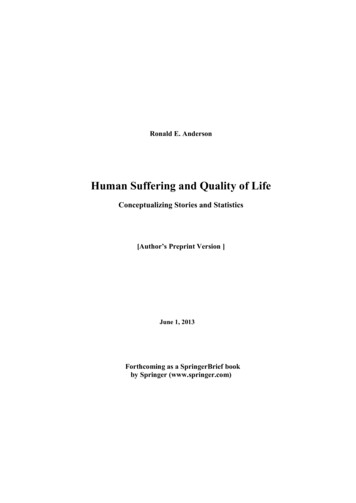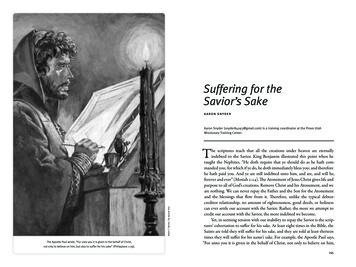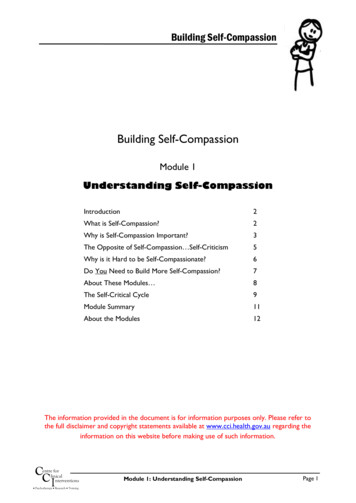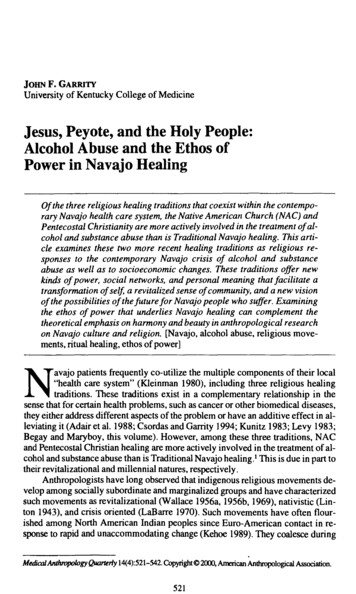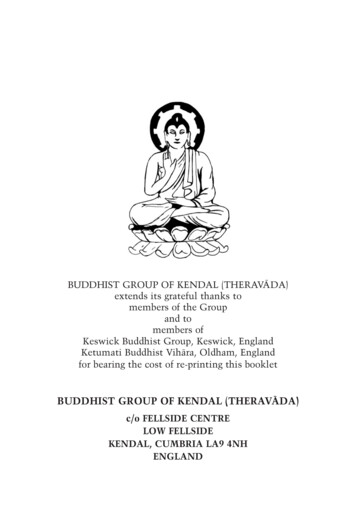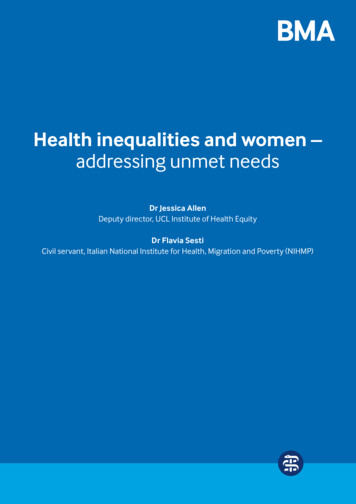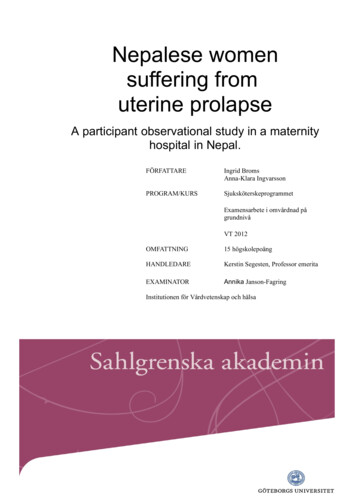
Transcription
Nepalese womensuffering fromuterine prolapseA participant observational study in a maternityhospital in Nepal.FÖRFATTAREIngrid BromsAnna-Klara ensarbete i omvårdnad pågrundnivåVT 2012OMFATTNING15 högskolepoängHANDLEDAREKerstin Segesten, Professor emeritaEXAMINATORAnnika Janson-FagringInstitutionen för Vårdvetenskap och hälsa
ACKNOWLEDGEMENTSIt has been an amazing journey writing this thesis. We were granted the opportunity ofvisiting the beautiful country of Nepal getting a unique insight into the care atParopakar Maternity & Women’s Hospital. This experience will be a valuable asset forus as nurses as well individuals. Along the process we have gotten to know wonderfuland helpful people that have all contributed in different ways to make our thesispossible.We would like to thank our supervisor Kerstin Segesten for sharing her knowledge inessay writing and guiding us through the whole process. We are truly grateful to LaxmiTamang for connecting us to the right people. Our warmest thanks to the women atMidwifery Society of Nepal (MIDSON) for taking such good care of us and for helpingus manage all the contacts with the hospital. Special thanks to Kiran Bajracharya andRashmi Rajopadhaya for acting as our mentors and for making us feel safe andwelcomed in the foreign city of Kathmandu. We highly appreciate the hospitalmanagement for providing us access to the hospital. Our deepest thanks to staff andpatients at Paropakar Maternity & Women’s Hospital for good cooperation and for theirhospitality and generosity. Many thanks to Shabnam Samal for making our observationspossible and for being our constant companion and culture broker at the hospital. Wethank Rup Kumar BK for his time and for introducing us to Shabnam. Thanks toKristina Castell for sharing valuable knowledge and broadening our view on theNepalese care of patients with uterine prolapse. We thank staff and patients at ward 313,Östra Sjukhuset Gothenburg, for having us and for sharing knowledge that made usbetter prepared before leaving for Nepal. We are thankful to Lisen Dellenborg andSusanne Åsman for their useful and well needed advice. Last but not least we want tothank our families for their unconditional support and encouragement throughout thewriting of this thesis.
Titel (engelsk):Nepalese women suffering from uterineprolapse- A participant observational study in a maternityhospital in Nepal.Arbetets art:Självständigt terskeprogrammetExamensarbete i omvårdnad på grundnivå OM5250Arbetets omfattning:15 HögskolepoängSidantal:33 sidorFörfattare:Ingrid BromsAnna-Klara IngvarssonHandledare:Kerstin SegestenExaminator:Annika Janson FagringABSTRACTBackground:Uterine prolapse is a condition in which the muscles and supporting ligaments holdingthe uterus in place gets too weak to keep the uterus in position. This causes the uterus todrop into the vaginal canal and results in a downward malposition of the uterus. Riskfactors for uterine prolapse are among others pregnancy and delivery, improper deliverytechniques, heavy work during and soon after pregnancy and heavy lifting. In Nepaluterine prolapse is one of the main causes for ill-health among women of reproductiveand post-menopausal age. According to the United Nations Population Fund (UNFPA),the high number of affected women in Nepal is due to, among other reasons, the lack ofskilled birth-attendants, women carrying heavy loads, lack of contraceptives and givingbirth to many children.Aim:The aim of our study was to gain knowledge of how patients with uterine prolapse arecared for in a maternity hospital in Nepal.Method:An ethnographic approach was used to meet the aim of our study. Data was collected byfour weeks of participant observations in a hospital in Kathmandu. The observationswere complemented by interviews with patients and staff.Findings:The most striking part found in our material was the limited resources and their impacton the care provided to patients with uterine prolapse. The quality of the care wascompromised by the lack of good facilities, material resources and manpower. Thiscreated a frustration among the staff as well as an unnecessary suffering for the patients.We identified three main categories in the data collected; Prerequisites for caregiving,Consequences for the patients and Consequences for the caregivers. These themes arepresented in sixteen subheadings lifting different aspects of how the lack of resourcesaffected the care.
ContentNEPAL. 7Health. 8Health care system in Nepal. 8Women’s Health and status. 8UTERINE PROLAPSE. 9Anatomy and patophysiology. 9Symptoms. 10Risk factors. 10Treatment.10Uterine prolapse in Nepal. 11Uterine prolapse in Sweden and globally. 11THE NURSING EDUCATION IN NEPAL. 11ETHNOGRAPHY. 12PARTICIPANT OBSERVATIONS. 12PRE-UNDERSTANDING. 13PREPERATIONS. 13SETTING. 14DATA COLLECTION . 14DATA ANALYSIS. 15ETHICAL CONSIDERATIONS. 15FINDINGS. 16PREREQUISITES FOR CAREGIVING. 17Environment. 17Equipment. 18Hygiene facilities. 18Staffing. 19Unwritten rules. 19CONCEQUENSES FOR THE PATIENTS.20Being embarrassed.20Involuntary sharing. 21Power imbalance . 22Lack of information. 22Relatives as caregivers.23Increased risk of infections. 23Compromised confidentiality. 24
CONSEQUENCES FOR THE CAREGIVERS.24Feeling of inadequacy. 24Making the best they could. 25Adjusting to the environment. 26Not meeting the patient needs. 26METHODOLOGY. 27FINDINGS. 29
INTRODUCTIONUterine prolapse is a condition which occurs among women all over the world. Withaccess to proper healthcare it is a condition easily prevented and treated (1). In Nepaluterine prolapse is one of the major health problems of women of re-productive- andmenopausal age. Because of low familial and social position, illiteracy, culturaltraditions and patriarchal structures women of the Nepalese society are vulnerable tohealth problems. These are also factors that make the reproductive health situation ofNepalese women very poor (2).Due to the remoteness and difficult terrain in Nepal the access to health care is severelyrestricted. Even when health care services are available there are factors that preventwomen from getting the care they need. Women are often deprived of the right to makedecisions concerning their own health care, including timing and spacing ofpregnancies. Usually the husband decides about health care expenses, and women arenot always allowed to travel alone which further complicates the process of seekingmedical care (3).Up until today the debate on uterine prolapse is very limited, both in the family and inthe society. Nepalese women suffering from uterine prolapse often keep the condition asecret, being afraid of condemnation and feeling ashamed. There is also a lack ofknowledge about the condition and as a result many women avoid seeking care (2,3).Both of us were interested in questions regarding women's health in developingcountries and in particular conditions that were connected to the social position ofwomen. One of us had been to Nepal before and when talking to Nepalese contactsabout women's health, uterine prolapse was mentioned as a major issue. We founduterine prolapse among Nepalese women a complex and interesting subject that wewanted to investigate further. As nursing students we were primarily interested in thecare provided.Our aim was to gain knowledge of how patients with uterine prolapse are cared for in aNepalese hospital and how the prerequisites of the hospital affect the care. We hope thatour findings will contribute to new insights for all involved and serve as a basis forreflection on this topic. Furthermore, we believe that our findings will be a valuableasset for us and our colleagues in Sweden. Swedish health care is not withoutlimitations of resources. We believe that reflecting on this matter is of great importance.Being aware of resources, their impact on the care and how you make the most out ofthem is important for Swedish nurses as well as Nepalese.
BACKGROUNDNEPALTable 1: Nepal Country FactsOfficial nameSanghiya Loktantrik Ganatantra Nepal/Federala demokratiskarepubliken NepalArea - km2147 181 (2010)Population29 852 682 (2010 estimate)CapitalKatmandu, population 990 000 (2010 estimate)GovernmentRepublicCurrencyNepalese Rupee (NPR)1 US Dollar (USD) 90.59933 NPR(4,5,6)Nepal is a landlocked republic located in Southern Asia in between India and China. Ithas a population of approximately 29 million of which 990,000 (2010) live in the capitalKathmandu (7). The official language is Nepali which is closely related to Hindi, butthere are several other languages and dialects spoken by different ethnic groups ofNepal. Furthermore English is commonly spoken among people in business andgovernment (4,7). Nepal is the seventeenth poorest country in the world and the poorestcountry of South Asia (5). In recent years the number of poor people has declined,mostly due to increased incomes from citizens working abroad. International aid andtourism also contribute to the possibility of growth for Nepal. However, 25% of thepopulation still live below the poverty line. Nepal is one of the least developed countriesin the world and more than 80% of the population live in rural areas. Agriculture is themost common livelihood and the industries are mainly processing the agriculturalproducts such as jute, tobacco, grain and pulse. Only about 7% of the population worksin the industries (4,7).Nepal is located on three ecological zones, the flat river plain in the south, the hillyregion in central Nepal and the mountains of Himalaya in the north. The landscape ofNepal, with its great differences in altitude, makes it hard to construct roads. Theinfrastructure is consequently poor. More than two thirds of the roads are unpaved andsome districts still are not connected to the road network (4). The poor infrastructuremeans a big challenge for Nepal regarding health and development (8).The diverse population of Nepal consists of a large number of groups defined by aboveall ethnicity, language and a complex caste system (4). Nowadays the caste system isprohibited, yet it is still present in the Nepalese society. The caste system and thepatriarchal structure of Nepal affect exposed groups, such as women and minoritygroups, as for instance by reducing their access to health services (8). Up until 2006Nepal was officially a Hindu state, but is now a secular nation (4). A majority of theNepalese people define themselves as Hindus. The second largest religion is Buddhism,followed by Islam (7).Nepal has suffered from political instability for about two decades. A multipartydemocracy was introduced in 1990 and since then there has been 20 governments (5). In2008 the former kingdom of Nepal was declared a federal democratic republic and themonarchy was abolished by the newly elected Constituent Assembly. The drafting ofthe constitution is still an ongoing process. The current Prime Minister Baburam
Bhattarai is working together with the leaders of the main political parties to be finishedwith the draft by May 2012 (7).HealthLife expectancy in Nepal is 65 years for males and 69 years for females. This can becompared to Sweden where the same number is 79 for males and 83 for females. Theinfant mortality rate in Nepal is high in comparison to Sweden. In Nepal the probabilityof dying before the age of five is estimated to 48 per 1000 live births, while only threeinfants per 1000 live births die in Sweden (9,10).The risk of being affected by infectious diseases is high in Nepal. Food or waterbornediseases such as diarrhea, typhoid fever and hepatitis A is a health issue in Nepal. Thereare also vector borne diseases like malaria and Japanese encephalitis (7). Diarrhea is themost common cause of death in children under the age of five. Malnutrition causes38.8% of the children in Nepal to be underweight, globally the same number is 7%(7,11).Health care system in NepalThere are three categories of health care providers in Nepal: public, private and NonGovernmental Organizations (NGO) (12). For every 10 000 inhabitants of Nepal thereare thirteen nurses and midwifes and two physicians (11). There are five hospital bedsper every 1000 of Nepal’s inhabitants (7).In Sweden the total expenditure per capita is 3690 USD compared to 69 USD in Nepal(9,10). The public spending on health in Nepal is low. The government expendituresonly cover roughly 37% of the total expenditure. Almost two-thirds of the money spentin health care in 2008 came from private sources. Out of these more than 70% camefrom out-of-pocket sources (13).In 1997 the Nepalese Government decided on a long term health plan in which the issueof women's health is stressed. The plan states that the health status of vulnerable groupslike women, the rural population, the under privileged and the poor must be improved.This is to be achieved through extended primary health care system in the rural areas,more trained health care providers, training and community participation and throughinvolvement of NGO: s and private sector in health services (14). The governmentprovides free health care and 1000 NPR to every woman that seeks help for uterineprolapse or gives birth at a hospital. The money is meant to cover transport charges andother expenses (K, Bajracharya. Personal communication. 2012-02-05). Nepal's healthpolicy encourages social justice and equity but there are still significant health gapsbetween rural and urban areas and the rich and the poor (8). There is also a problemwith accessibility to health facilities for the people in the rural areas of this mountainouscountry (3).Women’s Health and statusThe World Health Organization (WHO) about reproductive health:”Within the framework of WHO's definition of health as a state of completephysical, mental and social well-being, and not merely the absence of disease
or infirmity, reproductive health addresses the reproductive processes,functions and system at all stages of life. Reproductive health, therefore,implies that people are able to have a responsible, satisfying and safe sex lifeand that they have the capability to reproduce and the freedom to decide if,when and how often to do so.Implicit in this are the right of men and women to be informed of and to haveaccess to safe, effective, affordable and acceptable methods of fertilityregulation of their choice, and the right of access to appropriate health careservices that will enable women to go safely through pregnancy and childbirthand provide couples with the best chance of having a healthy infant” (15 no p).Women of the Nepalese society are particularly vulnerable to health problems. Theirlow familial and social position, illiteracy, cultural traditions and patriarchal structuresare all factors that make the reproductive health situation of Nepalese women very poor(3).The maternal mortality rate in Nepal is estimated to 380 per 100 000 live births,compared to the global average of 260 deaths per 100 000 live births (11). Surveysmade in 2006 showed that the number of births assisted by skilled personnel wereapproximately 19 %. Most births occurred in rural areas (88%) and out of these only 14% were attended by skilled birth attendants. In the same year less than half of themarried women used contraceptives (44%) (16). Almost a quarter of the femalepopulation is suffering from malnutrition (17).Women of Nepal often consider giving birth as a procedure that does not require anyspecial arrangements before, during or after delivery. Conceptions like this stem from alack of knowledge about the need to rest after delivery. This complicates efforts to getmore women to give birth in institutions with skilled personnel and for women tounderstand the importance of resting and not performing hard physical work too soonafter delivery (18).Due to remoteness and the difficult terrain in Nepal the access to health care is severelyrestricted. Even if health care services are available there are other factors that preventwomen from getting the care needed. Women are often deprived of the right to makedecisions concerning their own health care, including timing and spacing ofpregnancies. Usually the husband decides about health care expenses, and women arenot always allowed to travel alone which further complicates the process of seekingmedical care (3). Consequently Nepalese women in general do not have the same accessto and possibility to utilize basic services as men do (7).UTERINE PROLAPSEAnatomy and patophysiologyUterine prolapse is a condition in which the muscles and supporting ligaments holdingthe uterus in place gets too weak to keep the uterus in position. This causes the uterus todrop into the vaginal canal and results in a downward malposition of the uterus (19).This causes the vaginal walls to fall down toward or out of the opening of the vagina(20).There are four different components of uterus prolapse which can occur isolated or insome combination:
Cystocoele: Prolapse of the anterior wall of the vagina, which usually makes the bladderdescend and herniate the vaginaRectocoele: Prolapse of the posterior vaginal wall, rectum and sometimes the small orlarge bowel protrudes into the vaginal canal.Enterocoele: The small intestine bulge into the vagina like a hernia (20,21).Dispenses: Uterus descends into or out of the vagina (20).There are different stages of prolapse: (I) the leading edge of the prolapse is more than 1cm above the hymen, (II) the leading edge of the prolapse is less than 1cm proximal ordistal to the hymen, (III) the leading edge of the prolapse is more than 1 cm below thehymen but protrudes no further than 2 cm less than the vaginal length, (IV) completeeversion of the total length of the vagina (21,22).In stage two or three there is a risk of developing decubitus ulcers at the cervix orvaginal wall. This is due to the prolapse being in contact with the women’s clothes orthighs chafing (3).SymptomsAlthough women suffering from uterine prolapse may experience many symptoms thereis only one symptom that is specific for the condition. The uterine prolapse specificsymptom is the feeling of something bulging out of the vagina, a foreign body sensation(20). Other symptoms that uterine prolapse patients have reported are a sensation ofheaviness in the pelvis, vaginal bleeding, increased vaginal discharge, chafing, painfulor difficult sexual intercourse and low back ache (1,20).Because of the close position of the uterus to the bladder and bowel, the symptoms ofuterine prolapse can come from these organs. Bladder incontinence, which leads tofrequent urination, a sense of not being able to empty bladder or the feeling of suddenneeds to empty bladder are common. Constipation or the need to use the fingers to easethe defecation can be a consequence of prolapse (1,20).Risk factorsThe two main risk factors for uterine prolapse are pregnancy and delivery which causesa severe distention of the connective tissues. The risk increases if the repair of anyperineal injuries are neglected or not done properly. Other risk factors are aging andpostmenopausal hormone changes, chronic constipation, improper delivery techniques,delivery in young age, an infant birth weight over 4500g, frequent pregnancies,undernourished mothers, heavy physical work during and soon after pregnancy, heavylifting and prolonged labor (19-21,23).TreatmentUterine prolapse is preventable and easily treated. In first stage prolapse pelvicexercises are recommended to prevent a worsening of the condition (3,20). In secondstage a vaginal pessary, similar to those pessaries used for birth control, can be used tokeep the uterus in place. This treatment is often sufficient and no surgery will benecessary. A pessary can also be used while waiting for surgery (1,20). In third stageprolapse surgery is required. Surgery might also be required if treatment with pessary isnot working. For some women the pessary will not stay in place due to week ligament
support or a wide vaginal opening (20). The surgical options include hysterectomy(removal of the uterus) or the Manchester operation. The Manchester operation aims torecreate the anatomy of the women's pelvis by amending the stretching or disruption ofthe connective-tissue attachments and if necessary removing the cervix (20,21).Uterine prolapse in NepalUterine prolapse is one of the main causes for ill-health among Nepalese women ofreproductive and post-menopausal age (24). It is estimated that some 600 000 to 1million women suffer from uterine prolapse of which 200 000 is in need of immediatesurgery (18,19).According to the United Nations Population Fund (UNFPA), the reason for the highnumber of affected women in Nepal is, among others, the lack of skilled birthattendants, women carrying heavy loads, child marriage, lack of contraceptives andgiving birth to many children (23).Due to traditional gender roles, lack of knowledge about and the stigma surroundinguterine prolapse, many Nepalese women do not seek health care for their condition.They often keep the condition a secret, being afraid of condemnation and ashamedbecause it is the genitals that are affected (3). Further the women might not be in aposition where they are allowed to make decisions regarding their own reproductivehealth (18,19). Women suffering from uterine prolapse risk being rejected by theirhusbands, family and even by the community (18). Often the affected women do notknow that the condition is common and treatable (18,19).Uterine prolapse in Sweden and globallyIn Sweden it is estimated that one out of twelve women has symptoms of uterineprolapse and each year some six thousand women undergo surgery. Out of theseapproximately 20% will have a relapse that requires an additional operation. If thepatient feels that something bulges out of the vagina, has trouble emptying bladder,repeated urinary infections or if the symptoms of the prolapse affects the patientsquality of life in a negative way she will be offered surgery (25). The global prevalenceof genital prolapse among women under 45 years of age is estimated to 2-20% (19,26).THE NURSING EDUCATION IN NEPALThere are different lengths and forms of the nursing education in Nepal (K Bajracharya.Personal communication. 2012-02-01). Most of the students we met at ParopakarMaternity and Women’s’ Hospital studied a three year full time university education.The program is open to female student only. The six major themes of the education isdevelopment, communication, the nursing process, stress, teaching and learning andleadership. Three thirds of the last year is dedicated to theory and practical placementsin midwifery and gynecology. A total of 23 weeks are dedicated to clinical placementsin the field of midwifery and gynecology (27).
AIMThe aim of our study was to gain knowledge of how patients with uterine prolapse arecared for in a maternity hospital in Nepal.-Guiding questions were:What are the prerequisites for the care?How do the prerequisites impact the care of women with uterine prolapse?What consequences do the prerequisites mean for the caregivers?METHODETHNOGRAPHYEthnography is a method where the researcher studies cultural norms, rules andphenomena by observing human behavior in a specific context. The aim of anethnographic study is to gain an understanding of a certain culture. Within ethnography,culture is considered to be created in all groups of people and forms the individuals'ideas of life, the world and their actions. To gain this understanding the researcher needsto do fieldwork, be in the context of the group studied, observing the everyday life. Theresearcher reveals everyday events that are natural to the members of the group byasking questions about what is happening, what is being done and why. The researchercan choose in what extent to participate in the life of the people observed, depending onwhat the researcher believes will be the best approach for the study. Ethnography is amethod where you try to understand a culture from inside, the reality as seen from themembers of the group members' perspective (28).Ethnography is a “free” method where the researcher has to create the study by him orherself. There is no template to follow but only guidelines to guide the researcher indeveloping a study that will meet the aim of the study (28). According to Leininger themethod of ethnography can be described as follows:“the systematic process of observing, detailing, describing, documenting andanalyzing the lifeways or particular patterns of a culture (or subculture) inorder to grasp the lifeways or patterns of the people in their familiarenvironment” (29, p35).We decided to have an ethnographic approach since our aim was to get anunderstanding of behavior and perceptions in the environment we studied.PARTICIPANT OBSERVATIONSParticipant observations are commonly viewed as a qualitative data collection method.The aim of the participant observations is to gain knowledge by getting intimatelyfamiliar with a group of individuals and study their context from inside. Byparticipating in their everyday life the researcher receives information about values,norms and different patterns characterizing the social context studied. There are fewformal rules on how to execute participant observations. The result comes down to for
instance what the group chooses to share and the researcher’s capacity in presence ofmind, creativity, sensitivity and patience. Participant observati
BACKGROUND NEPAL Table 1: Nepal Country Facts Official name Sanghiya Loktantrik Ganatantra Nepal/Federala demokratiska republiken Nepal Area - km2 147 181 (2010) Population 29 852 682 (2010 estimate) Capital Katmandu, population 990 000 (2010 estimate) Government Republic Currency Nepalese Rupee (NPR) 1 US Dollar (USD) 90.59933 NPR
